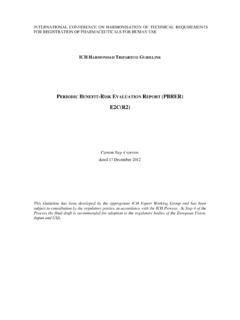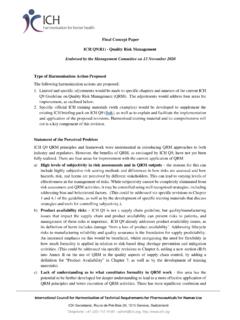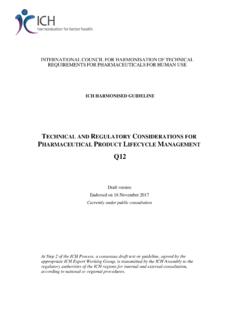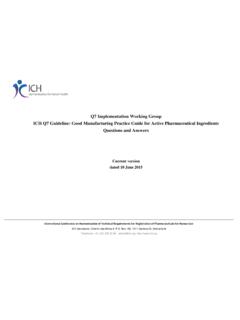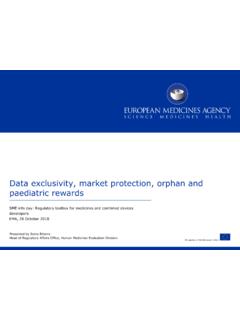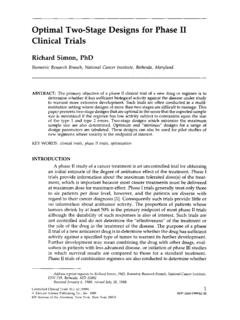Transcription of Nonclinical Safety Studies for the Conduct of Human ...
1 International Conference on Harmonisation of TechnicalRequirements for Registration of Pharmaceuticals for Human UseICH M3 (R2) Guideline on Nonclinical Safety Studies for the Conduct of Human clinical Trials and Marketing Authorization for PharmaceuticalsBackground Major revisions to ICHM3(R1) were begun in 2006 ICHM3(R1) had only a few minor editorial changes to the original ICHM3 ICHM3(R1) had a number of areas for which harmonization had not been fully achieved in original guidance (ICHM3) more than 10 years ago Consideration of recent regulatory documents was desirable Step 2 reached in June 2008 Objectives of ICHM3 To recommend international standards for, and promote harmonisation of, the Nonclinical Safety Studies to support Human clinical trials of a given scope and duration, and for the marketing authorization of drug productsScope of Revisions to ICHM3(R1) (a) Acute toxicity Studies Limit dose in toxicity Studies Duration of repeat dose Studies for non-rodents Estimation of the first dose in Human Exploratory clinical Studies .
2 Limited clinical Studies with Nonclinical testing program directed only to support those early exploratory approaches Genotoxicity studiesScope of Revisions to ICHM3(R1) (b) Reproduction toxicity Studies Timing for special Studies Toxicity Studies to support clinical trials in Pediatric population Immunotoxicity Studies Phototoxicity Studies Nonclinical Abuse liability Studies fixed combination drug non- clinical studiesAcute Toxicity Studies Stand alone Studies rarely needed Short-term, dose-limiting toxicity can be learned from repeat-dose Studies Information on the short-term dose-limiting toxicity of pharmaceuticals should be available prior to Phase 3 Limit Dose for General Toxicity Studies Dose limit- 1000 mg/kg/day for rodents and non-rodents if the Human dose does not exceed 1 g per day and there are 10x margins to clinical exposureOR Exposure margin limit- Only need to go to 50x the maximum Human exposure at the anticipated max recommended Human dose In if dose-limiting toxicity has not been identified, 1 study of at least 1 month recommended before phase 3 study at MFD or MTD.
3 Whichever is lowerDuration of Repeated Dose Toxicity Studies in Non-rodents Reviewed data for all accumulated datasets (dogs, primarily) for about 150 compounds developed for diverse indications from EU countries, the , and Japan--1999-2006 Re-evaluated 6 vs 9 vs 12 months for opportunity to minimize exceptions to 9 month s durationDuration of Repeated Dose Studies in Non-rodents Criterion: Would clinical decisions have changed based on new toxicity uncovered in longer term Studies ? 6 months in non-rodents (primarily dogs) is usually but not always sufficient No data that show that 9 months is not sufficient 9 month non-rodent chronic Studies should be adequate to support chronic use in Human (small molecules) without exceptionExploratory clinical Studies (a) 5 exploratory clinical Studies approaches (no therapeutic or diagnostic intent, MTD not examined) are described as examples.
4 Supportive non- clinical programs are focused on direct support of those early clinical Studies with limited clinical objectives, not on further developmentFive Exploratory clinical Studies (b) Two microdose approaches Total dose of 100 g Up to 5 administration of a maximum of 100 g/administration Single dose subtherapeutic Studies Two Repeated dose exploratory Studies : Exposure based (overage approach) Duration of clinical trial up to duration of dosing in non rodent toxicity Studies ; an alternate pathMicrodose Approach- 1 Total dose of 100 g, max of 5 administrations and 1/100thNOAEL and 1/100thPharmacologically active dose, scaled Extended single dose tox study in 1 species by intended route and PK; max dose of 1000x clinical dose, scaled PD profile in vitro and in relevant model; genetox not needed Microdose Approach- 2 Total dose of 500 g, 100 g per dose, max of 5 administrations, with washout between and 1/100thNOAEL and 1/100thPharmacologically active dose, scaled 7-d repeat dose tox study in 1 species by intended route and PK; max dose of 1000x clinical dose, scaled PD profile in vitro and in relevant model; genetox not needed 3.
5 Single Dose Subtherapeutic clinical Studies Starting clinical dose depends on toxicity in extended single dose toxicity Studies in rodents and nonrodents in which top dose was MTD, MFD, or limit dose Max clinical dose: the NOAEL exposure in the more sensitive species, if tox is monitorable and reversible nonclin Safety pharm; Ames assay4. Single or Repeated Dose clinical Studies into Therapeutic Range but Not to Evaluate MTD, Exposure Based (a) Starting Dose: If tox in both species: follow regional guidance for the starting dose Without any tox in either species or tox in one species, starting clinical dose should not exceed 1/50 the NOAEL in the more sensitive species (mg/m2); for other considerations, follow regional guidance4.
6 Single or Repeated Dose clinical Studies into Therapeutic Range but Not to Evaluate MTD, Exposure Based (b) Max Clin dose: With tox in both species, max clin dose based on std risk assessment but typically would not exceed the lowest NOAEL AUC Without tox in both species, clin dosing up to 1/10 the lower exposure (AUC) in either species at highest dose tested If tox in one species, max clin dose would be whatever gave the lower exposure of the above 2 options4. Single or Repeated Dose clinical Studies into Therapeutic Range but Not to Evaluate MTD, Exposure Based (c) Std 2-wk repeat dose toxicity Studies in rodent and nonrodents, with dose selection in animals based on multiples of the anticipated clinical AUC at the max dose Nonclin Safety pharm; Ames assay5.
7 Single or Repeated Dose clinical Studies into Therapeutic Range but Not to Evaluate MTD (linked to duration) (a) Starting clinical dose should not exceed 1/50 the NOAEL in the more sensitive species(mg/m2) Max clinical dose: not higher than the AUC at the NOAEL exposure in the nonrodents or 1/2 AUC at the NOAEL in the rodent species, whatever is lower (up to 14 days)5. Single or Repeated Dose clinical Studies into Therapeutic Range but Not to Evaluate MTD (linked to duration) (b) Std 2-wk repeat dose toxicity Studies in rodent (with justification for rodent) and, confirmatory study in nonrodent with duration of a minimum of 3 days and up to clinical study duration Nonclin Safety pharmGenotoxicity Studies A gene mutation assay is sufficient to support all single dose clinical development trials For multiple dose clinical development trials, choice of two batteries of tests, Option 1 and Option 2.
8 Described in the ICH S2R document Reproduction Toxicity Studies (a) Nature and timing of reproductive toxicity Studies to support the Conduct of different phases of clinical trials Reviewed data sets from dose ranging and definitive Studies in rats and rabbits (several hundred drugsdeveloped for diverse indications from EU countries, the , and Japan--1999-2006 Criterion: How well do dose-ranging Studies predict those results of definitive Studies that would changed clinical decisions or have an impact on Toxicity Studies (b) When dose-ranging Studies are available and visceral/skeletal examinations are conducted good predictivity WOCBP (up to 150) with control of pregnancy risk could receive investigational treatment for up to 3 months before completion of definitive reproductive toxicity Studies WOCBP= women of child-bearing potentialReproduction Toxicity Studies (c))
9 FDA allows such clinical trials without dose-ranging Studies In the EU and Japan, although definitive Studies are generally required to support inclusion of WOCBP in clinical Studies , some situations are defined where early clinical Studies could be conducted in WOCBP before completing embryo-fetal developmental Studies in animals. These include short duration clinical trials (such as 2 weeks) with intensive control of pregnancy for Special Studies Toxicity Studies to support clinical trials in Pediatric population Immunotoxicity Studies Phototoxicity Studies Nonclinical Abuse liability Studies fixed combination drug non- clinical studies3Rs Achievements (a)Overall harmonization will result in reduction and refinement of animal use: Separate acute toxicity Studies were eliminated.
10 (reduction) Repeated dose toxicity Studies now have exposure and dose limits to establish valid study designs. (refinement and reduction of the need to repeat Studies )3Rs Achievements (b) New exploratory clinical Studies section will reduce use of animals needed to support clinical Studies and offer refinement of toxicology study design. (reduction and refinement) Local tolerance toxicity: recommended against stand alone designs. (reduction) Reproductive toxicity Studies are deferred until later in development and this will result in elimination of Studies for failed compounds. (reduction)3Rs Achievements (c) Pediatric recommendations will eliminate routine use of second juvenile toxicity study and minimize when juvenile toxicity Studies are needed.
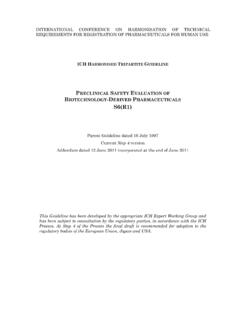
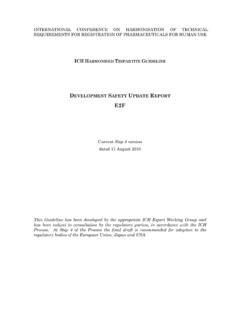
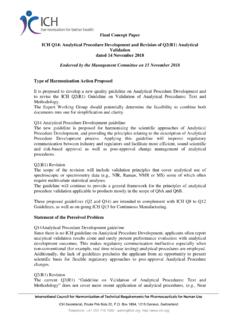
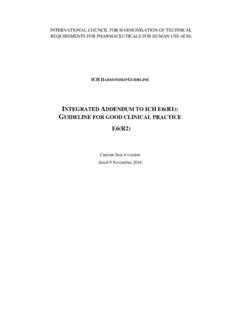
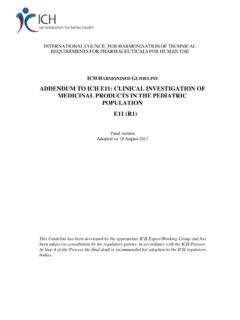
![[ICH E2F] [EXAMPLE DSUR – PHASE III INVESTIGATIONAL …](/cache/preview/e/7/a/2/e/6/3/0/thumb-e7a2e63043c4463724e748eb98faa3a7.jpg)
